![]() HISTORY!
HISTORY!
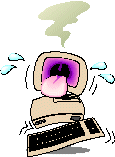
"*WHEW*! So hungry...
but just can't catch that ![]() !"
!"
Steve Jobs had worked during the summer at an apple farm, and admired the Beatles'
record label, Apple. He also believed Apples to be the most perfect fruit. He and Steve
Wozniak were trying to figure out a name for their new company, and they decided that if
they couldn't think of one by the end of the day that was better than Apple, they'd chose
Apple. They couldn't think of anything better, so on April 1, 1976, Apple Computer, Inc. was
born.
But they needed a logo. The first design included Sir Isaac Newton, a tree and a banner
that said "Apple Computer." Jobs decided they needed a less busy logo, one that would
signify a brand. The second logo attempt was very similar to the current logo, but without
the bite taken out of it. Jobs thought this logo looked too much like an orange. The third
attempt was the logo that Apple still uses.
The Apple I
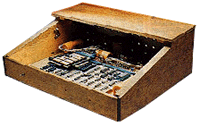
Codename: ??
CPU: MOS Technology 6502
CPU speed: 1 Mhz
FPU: none
motherboard RAM: 8 k
maximum RAM: 32 k (65 k hacked)
number of sockets: n/a
minimum speed: n/a
VRAM: 1 k ROM: ?
L1 cache: n/a
L2 cache: n/a
data path: 8 bit
bus speed: 1 Mhz
slots: ??
SCSI: none
Serial Ports:none
ADB: none
Floppy: optional
HD: none
Display: 60.05 Hz, 40x24
text, w/ automatic scrolling
Sound Output: ??
power: ??
introduced: April 1976
terminated: 1977
The Apple I was Steven Wozniak's first contribution to the personal
computer field. It was designed over a period of years, and was only
built in printed circuit-board form when Steve Jobs insisted it could be
sold. It debuted in April 1976 at the Homebrew Computer Club in Palo
Alto, but few took it seriously. The Apple I was based on the MOStek
6502 chip, whereas most other "kit" computers were built from the Intel
8080. The Apple I was sold through several small retailers, and
included only the circuit board. A tape-interface was sold separately, but
you had to build the case. The Apple I's initial cost was $666.66
The iMac (Rev. C/D)

Codename: Columbus
CPU: PowerPC 750
CPU speed: 266(C)/333(D) Mhz
FPU: integrated
motherboard RAM: 0 MB
maximum RAM: 384 MB
number of sockets: 2 -- 144 pin
SDRAM DIMM
minimum speed: 100 Mhz/10 ns
VRAM: 6 MB SGRAM
built-in 64-bit 2D/3D graphics
accelerator
ROM: 1 MB (3 MB toolbox ROM
loaded into RAM)
L1 cache: 32 k data, 32 k instruction
L2 cache: 512 k MB backside (1:2)
data path: 64 bit
bus speed: 66 Mhz
slots: none
SCSI: none
Serial Ports: none
ADB: none
USB: 2
Floppy: none
HD: 6 GB (ATA)
CD-ROM: 24x
monitor: 15" RGB 24 bit (millions of colors) at 1024x768
Sound Output: stereo 16 bit SRS (built in speaker)
Sound Input: stereo 16 bit (built in mono mic)
Ethernet: 10/100B-T
Gestalt ID: 406
power: 80 watts
Weight: 40 lbs. Dimensions: 15.8" H x 15.2" W x 17.6" D
Min System Software: 8.5.1
Max System Software: 8.5.1
introduced: January 1999(C)/April 1999(D)
terminated: April 1999(C)
Announced in January 1999, the Rev. C iMac came in 5 dazzling new
colors: Blueberry, Strawberry, Lime, Tangerine and Grape. Essentially a
speed-bump of the original iMac, the Rev C. lacked both the mysterious
"mezzanine" slot and the IRDA port, which lowered its price to $1199. In
April, Apple Replaced the Rev. C with the Rev. D iMac, bumping the
priocessor speed to 333 Mhz. All other specs were the same.
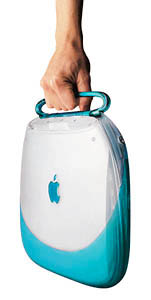
Codename: P1
CPU: PowerPC 750
CPU speed: 300 Mhz
FPU: integrated
motherboard RAM: 32 MB
maximum RAM: 160 MB
number of sockets: 1 -- 144 pin SDRAM SO-DIMM
minimum speed: 100 Mhz/10 ns
VRAM: 4 MB SDRAM
built-in 64-bit 2D/3D ATI RAGE Mobility (2X AGP)
ROM: ? 1 MB (3 MB toolbox ROM loaded into RAM)
L1 cache: 32 k data, 32 k instruction
L2 cache: 512 k MB backside (1:2)
data path: 64 bit
bus speed: 66 Mhz
slots: mezzanine
SCSI: none
Serial Ports: none
ADB: none
USB: 1
Floppy: none
modem: 56k
HD: 3.2 GB IDE
CD-ROM: 24x
display: 12.1" RGB 24 bit (millions of colors) at 800x600
Sound Output: stereo 16 bit SRS (built in mono speaker)
Sound Input: none
Ethernet: 10/100B-T
Airport: Optional card
Gestalt ID: 406
power: 45 watts
Battery life: up to 6 hours
Weight: 6.6 lbs.
Dimensions: 11.6" H x 13.5" W x 1.8" D
Min System Software: 8.6
Max System Software: 9.0
introduced: September 1999
terminated:

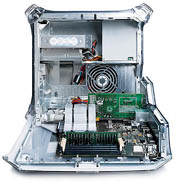
Codename: Sawtooth
CPU: MPC 7400
CPU speed: 450/500 Mhz
FPU: integrated
motherboard RAM: 0 MB
maximum RAM: 1.5 GB
number of sockets: 3 -- PC100 SDRAM
DIMM
minimum speed: 100 Mhz/10 ns
VRAM: 16 MB
ATI RAGE 128 2D/3D graphics card
ROM: 1 MB, (3 MB loaded into RAM)
L1 cache: 32 k data, 32 k instruction
L2 cache: 1 MB backside (1:2)
data path: 64 bit
bus speed: 100 Mhz (up to 800Mhz
memory throughput)
slots: 3 64-bit 66Mhz PCI, 1 133Mhz (2x) AGP (used by graphics card)
SCSI: optional PCI card
Serial Ports: none
ADB: none
USB: 2 (12 Mbs each)
FireWire: 3 400 Mbps (one internal) Floppy:
none
Zip: 1 100MB
AirPort: optional card
HD: min. 20 GB Ultra ATA-66 (up to 3 36GB
available as BTO option)
CD-ROM: DVD-ROM/RAM
Display: supports all resolutions
Sound Output: stereo 16 bit
Sound Input: stereo 16 bit
Ethernet: 10/100B-T (1000B-T avaiable as
BTO option)
Gestalt ID: 406
power: 200 Watts
Weight: 28.7 lbs.
Dimensions: 17" H x 8.9" W x 18.4"
Min System Software: 9.0
Max System Software: 9.0
introduced: September 1999
terminated:

The above Apple information is used "by permission" of the webmaster of the above mentioned Apple History website. Use of this material WITHOUT permission is strictly forbidden. Please be considerate and ask first!
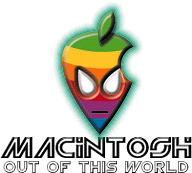

 PLEASE BOOKMARK THIS SITE! MORE PAGES COMING!
PLEASE BOOKMARK THIS SITE! MORE PAGES COMING!
![]()